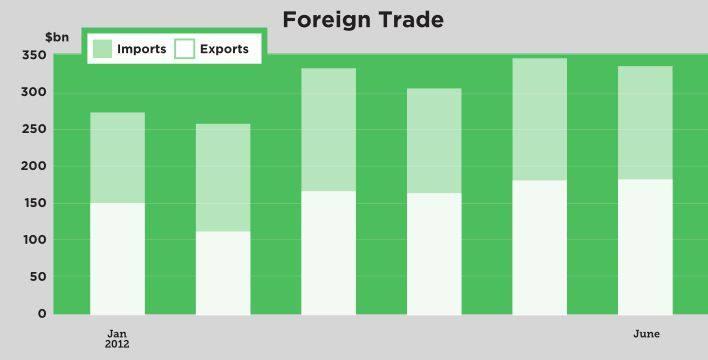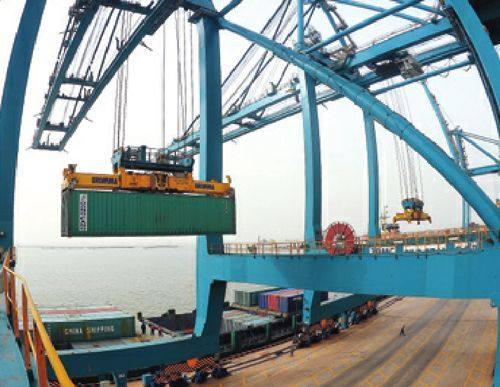Staying on Target
By Lan Xinzhen



Chinas economic growth continues to slow as predicted. According to figures from the National Bureau of Statistics (NBS), Chinas GDP grew by 7.6 percent in the second quarter, 0.5 percentage points lower than the growth in the first quarter. The GDP growth has dropped for five consecutive quarters. Its growth rate in the first half of the year was 7.8 percent. Meanwhile, the growth of the consumer price index (CPI) declined to 2.2 percent in June, further alleviating the inflation burden on consumers. Now, slow economic growth and low inflation have become the main characteristics of the Chinese economy.
Despite the slowdown, worries of a possible hard landing are unfounded since growth is still within the expected range set by the government earlier this year. According to the government work report, the target of eco- nomic growth this year is 7.5 percent.
To cope with the slowdown, the government has launched a series of measures, as addressed in Beijing Reviews cover story of issue No. 25 this year. Particularly, the Peoples Bank of China, the countrys central bank, lowered benchmark interest rates on July 6 for the second time in a month. This indicates the governments intention to relax monetary supply and raise market liquidity to stimulate the economy.
Zhang Liqun, a researcher at the Development Research Center of the State Council, said the governments top priority must be preventing the slowdown from affecting peoples lives.
Why so slow?
Compared with the strong economic growth of the past three decades, especially the robust recovery after the global financial crisis in 2008, the Chinese economic growth has seen a downturn since the fourth quarter of 2010. If the economy experiences a hard landing, it would send shockwaves throughout the world. In spite of a series of measures by the Chinese Government to stabilize growth, economic figures for the second quarter still showed no signs of a pickup.
The sluggish economy is the result of a simultaneous slowdown of both external and domestic demand, said a report by the Bank of Communications.
E u r o p e a n d the United States are Chinas major export destinations. However, due to the sovereign debt crisis, demand from these two major markets continues waning. Figures from the Ministry of Industry and Information Technology showed that in the first five months of this year, textile exports to the EU dropped by 11.2 percent.
Some policies have also weakened the internal impetus of the Chinese economy. For example, growth of investment in real estate development has been in decline due to tight control, sluggish sales and reduced source of capital. Moreover, because of the govern- ment-led economic restructuring—curbing investment in industries of high energy consumption, high pollution and surplus production capacity—industrial investment is also declining.
According to NBS figures, in the first half of this year, fixed-asset investment rose by 20.4 percent, a decline of 5.2 percentage points from last year.
The real economy is hence affected. In the first half, the average daily power generation, rolled steel output and crude oil processing saw sharp declines, indicating the lackluster prospects for business operations of enterprises. In June, the purchasing managers index(PMI) stood at 50.2 percent, 0.2 percentage points lower than that of previous month.
Liu Yuanchun, Vice Dean of the School of Economics of Renmin University of China, said the latest economic slowdown is mainly caused by external factors. “Under the background of globalization, world economy deeply affects the Chinese economy,” Liu said.
Effective measures
Lian Ping, chief economist at the Bank of Communications, said with recent government measures, both external and domestic demands have started to recover since May, and economic growth is expected to pick up in the third quarter.
Policies promoting investments are producing results. In late May, the National Development and Reform Commission approved a number of major investment projects. With implementation of these projects, growth of fixed-asset investment is expected to pick up in the third quarter.
Bank of Communications report said year-on-year growth of retail sales of consumer goods had been in decline since the end of last year, dropping from 17 percent to 14.5 percent in May. But with real estate transactions on the rise and subsidies to energy-saving home appliances being implemented en masse, consumption growth begins to pick up.
The whole year
Experts predict the economic situation in the second half will be better than the first and the GDP growth is likely to be more than 8 percent.
“The general trend of Chinese economic development has not changed,” said Zhu Baoliang, a researcher at the State Information Center. Zhu predicted that Chinese economic growth will pick up in the third quarter and continue to grow in the fourth quarter.
Lian also said economic growth will see an upturn in the third quarter because of four factors: recovering export growth alleviating worries of a rapid economic downturn; recovering growth of investment in real estate and infrastructure helping to stabilize growth of fixed-asset investment; policy stimulus and slower growth of prices will be conducive to the stable growth of consumption; and the financial sector is offering bigger backup to the real economy.
Zhang said this years economic situation will see “a drop in the first half but stability in the second half.”
The way in which policies of stabilizing economic growth are implemented will be decisive to the outcome of the second half, said Zhang. He suggested that structural tax reduction policy continue to be carried out to alleviate tax burdens on enterprises. Prudent monetary policy should be continued so as to sustain a reasonable financing scale. Credit structure should be further optimized to better satisfy the demand of the real economy.
Expanding domestic demand should be the focus to promote economic growth in the second half, said Zhang. The government should improve the policies of stimulating consumption, such as subsidies to energy-saving products, and supporting new energy products to be applied by public facilities and households. The government has arranged more than 26 billion yuan ($4.11 billion) to subsidize sale of energy-saving home appliances.
A report by Anbound, a Beijing-based independent consulting firm, warned the government of a rebound of housing prices in the second half, which could affect sound economic development. In June, a blowout of transaction volume and slight housing price hikes in major cities intensified such worries.
Yi Xianrong, a researcher at the Institute of Finance and Banking of the Chinese Academy of Social Sciences, said housing prices in major cities stopped dropping in June. This is not because of so-called “rigid demand” of home purchases, but that a series of measures to stabilize growth has changed expectations on the real estate market.
If Chinas housing market sees a simultaneous increase of transaction volume and prices, macro-control measures on the market implemented two years ago will ultimately fail, said Yi.
“If the central bank further relaxes the monetary policy in the second half, the already big real estate bubbles will continue to expand, while risks brought by the bubbles will be much larger than the benefits brought by stabilizing economic growth,” Yi said.
Forecasting Chinas GDP Growth in 2012
The prospects for a soft landing remain high, with growth expected at 8.2 percent in 2012 and 8.6 percent in 2013.
China Quarterly Update, World Bank(April 2012)
Chinas economic growth will likely moderate to around 8 percent this year amid downward risks caused by the ongoing crisis in Europe. The revision (from 8.2 percent predicted by the IMF in April to 8 percent) is still a comfortable growth for China.
David Lipton, First Deputy Managing Director of the IMF (June 2012)
Chinas GDP growth is forecast at 8.5 percent in 2012 and 8.7 percent in 2013. Inflation is forecast to decline to about 4 percent.
Asian Development Outlook 2012, Asian Development Bank (April 2012)
Chinas GDP growth will still be 8 percent in 2012, lower than the average annual 10.5 percent in 2007-11.
Fitch Ratings (June 2012)
The second quarter may be the bottom of economic growth and since the third quarter economic growth will recover to 8 percent and above, with possibility of a soft landing remaining high. GDP growth is expected to reach 8.2 percent in the third quarter of 2012.
Institute of International Finance, Bank of China (June 2012)

